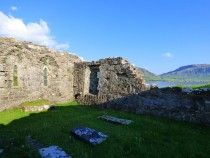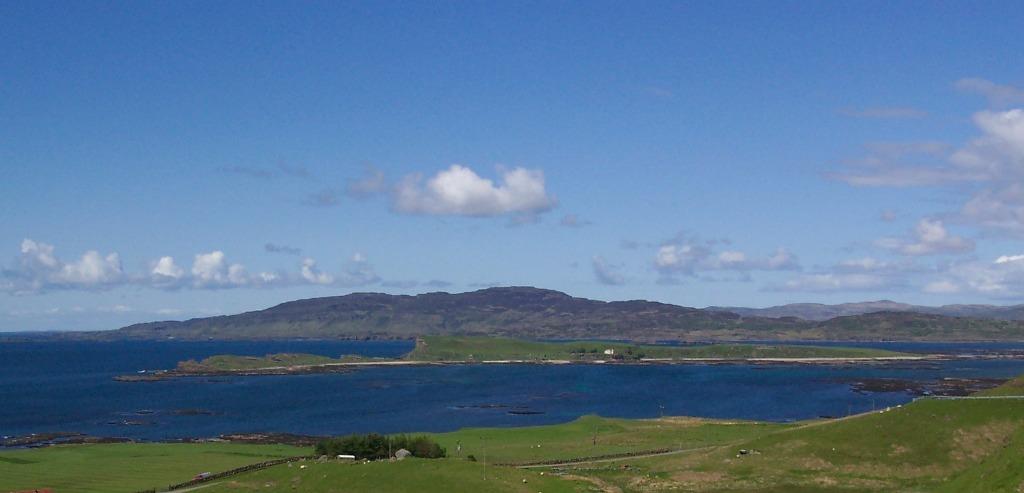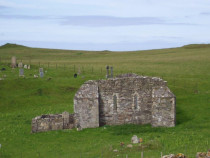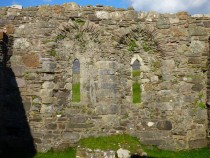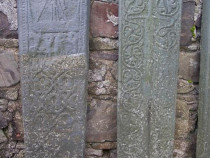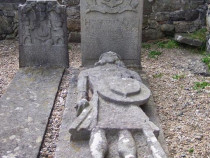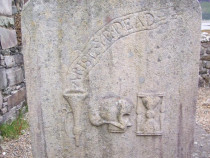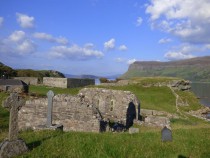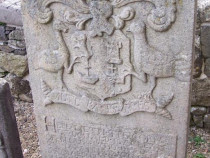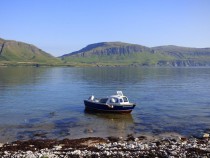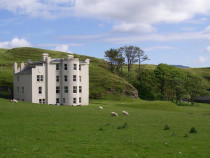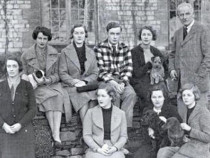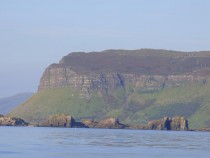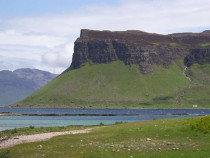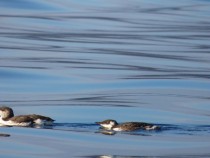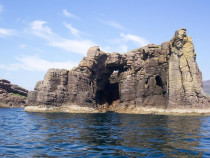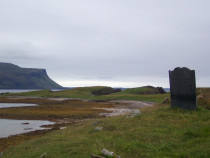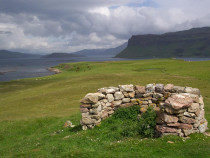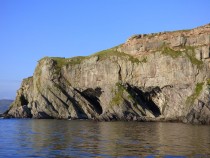Isle of Inch Kenneth once granery of Iona,a medieval chapel and once home of the Mitford family-a small island with long history
OS grid reference Explorer Series: 438 356
MAP OS EXPLORER 375 EAST MULL
Inch Kenneth has a fascinating and intriguing history and has captivated the imagination of many people over the centuries; John in particular loves this wee island and over the years has been fortunate enough to land on it in his own boat several times whilst out fishing for lobsters, whilst working for Historic Scotland (who maintains the ancient chapel and the land around it) and as an interested visitor. Over the years he has taken a number of photographs of the ruins and the main house, as well some shots from the higher ground back to west and south Mull. It is an idyllic and peaceful oasis with an extraordinary history.
Inch Kenneth (Scottish Gaelic - Innis Choinnich; meaning - Island of Kenneth) is a small island situated at the mouth of Loch Na Keal lying off the west coast of Mull close to the Mull shore on it’s south side and to the south south-east of the isle of Ulva. It’s geological composition is different from that of Mull and the 130 acres that make up the island are grassy and extremely fertile. As well as Mull, Inch Kenneth has a number of other islands as its neighbours including Eorsa, Gometra, Little Colonsay, Staffa, Ulva and the Treshnish Isles read more . It is accessible by boat only.
EARLY HISTORY CLICK ON PHOTO TO ENLARGE
Since Neolithic times Inch Kenneth has been a place of faith and ritual, a culturally significant place with a fascinating history.
The island is said to take it's name from St. Kenneth(Cainnech of Aghaboe), a contemporary of St Columba who is said to have founded a monastery on the island. There are ruins of a 12th century chapel on the island with its double lancet window on the east wall. The base of the alter can be seen along with funeral monuments and carved stones dating from mediaeval times.
Much of the grain produced on the island by the nuns was sent by boat to Iona.
14TH - 16 CENTURY
Most stones found around the chapel commemorate the MacLean's but it is said that Kings of Scotland were buried here if storms prevented passage to Iona. The stones are carved with various intricate carvings of animals, plant scrolls, ring knots, galleys and swords, and are from the period 14th, 15th and 16th century.
Beside the church within the graveyard grounds is a sandstone slab bearing a full length effigy of an armed man in high relief (see right), his head rests on a cushion and his feet against a lion or hound. In his right hand he holds a round object, perhaps a cannonball, on his left arm a targe bearing a raised shield on which a coat of arms was once carved or painted. Suspended from the waist belt is a sword resembling that of a 16th century claymore, while at his right hip is a dirk.
In the graveyard a ring-headed cross of slate designed as a Latin Cross, the shaft is bordered on each side by a chevron pattern. Towards the base of the shaft, there is a pair of shears
and a single-sided comb. It possibly dates from 1500-1560.
Also another large headstone commemorating Donald MacLean (3rd) of Brolas who died in 1725. On the front of the stone an achievement similar to that
on the tombstone of Lady MacLean, with the motto “ATERA MERCES” (another reward). On the reverse are carved in relief a skull, an hour-glass, and a trump from which proceed the words“ARISE YE DEAD”.
A headstone commemorating Dame Mary MacPherson, Lady MacLean, who died aged 30 can also be seen. On the front is carved a heraldic achievement with a shield charged for MacPherson, a galley, sail furled, a sinister hand holding a dagger. The supporters are two men wearing plumed helmets and carrying targes. On the back of the slab is carved the armorial achievement of the MacLeans of Duart, the shield bearing quarterly, a lion rampant, a castle embattled, a galley and a salmon, a dexter hand cupped holding a cross. The supporters are two ostriches, and a
skull and cross bones are incised at the base.
EIGHTEEN CENTURY ONWARDS
Inch Kenneth was visited in 1773 by Samuel Johnson and James Boswell during their tour of the Hebrides; they were entertained there by Sir Allan MacLean (1710-1783), 22nd chief and head of the Maclean clan. Both Johnson and Boswell published accounts of their visit to Inch Kenneth, most notably 'Journal of a Tour to the Hebrides with Samuel Johnson' which was first published in 1785. In the 1930s the island was owned by Sir Harold Edwin Boulton (1859 -1935), the writer of the words to the Skye Boat Song, with his second wife Margaret Cunningham Lyons. I don't know who the owners of Inch Kenneth before them and there is little information available about the original house that is currently standing there - when it was built, by whom and what it looked like. Maps of the island from the early 1900's indicate a structure of some kind along with the farm house, outbuildings and walled pastures. The site of the ruined chapel is clearly mapped. The Boultons adapted and enlarged an earlier house built on the island sometime in the 1830's to create the large house that exists on Inch Kenneth today.
The house is described as follows, taken from the words of Neil MacGillivray as told in Timothy Neats charming book 'When I was Young; Voices from Lost Communities in Scotland (The Islands)' - "It was the Boltons who made the last major renovations to Inchkenneth House. It's a nineteenth century baronial type building adapted in the thirties. It's part Highland castle, part country house and part art deco mansion - that's the quality the Boltons added. They waterproofed and upgraded the whole building. Sir Harold built a private chapel, next to the bedrooms on the top floor.................The builders for the Boltons did a good job. By adding a bow front to the house they created more light and beautiful views all through 180 degrees...." Neil MacGillivray's reminiscences in this book also includes some curious comments and observations about the Boultons although I don't know how accurate they are. He does give a unique insight into life on the island during his own lifetime.
Following the death of Sir Harold in 1935 and his second wife Lady Margaret on 18 October 1938, Inch Kenneth was sold to its most famous owners - the eccentric Mitford family in
1939. Lord and Lady Redesdale were parents to six daughters and one son, Nancy, Pamela, Thomas, Diana, Unity, Jessica and Deborah. Although the full family name was Freeman-Mitford, they were generally known as Mitford and collectively the sisters were termed The Mitford Girls. The family have an incredible and fascinating history and as well as numerous books being published about them as well as being written by them, just a wee browse round the internet will throw up a plethora of information and speculation about this rather unique family.
Unity, the fourth daughter, was besotted by Hitler and on the declaration of war, was so devastated she tried to commit suicide and shooting herself in the head. The bullet lodged in her brain but did not kill her. Hitler arranged for her return to England and is said to have rung often to ask how she was. She had a personality change from the brain damage and lived on the island during her final years being cared for by her mother and sister(s). Unity died aged 33 from meningitis brought on by the wound which ended her life in Oban Hospital in 1948. Following the death of their mother, Lady Redesdale in 1963, the island was inherited by the surviving Mitford sisters. Diana, Nancy, Deborah and Pamela sold their shares in the island to their sister and fellow beneficiary Jessica. A former communist, Jessica became a fine writer and recorded their strange childhood in a book called “Hons
and Rebels”. She states that most of the windows in their various homes were decorated with a swastika, etched on the glass by one of the daughters, and above each swastika there was a hammer and sickle etched by herself. Teasingly Jessica suggested that Inch Kenneth might become a Soviet submarine base.
The island was sold by Jessica Mitford in 1966 to its current owner - it remains under private ownership. Inch Kenneth
was one of the locations for the 1993 feature film Walk Me Home produced by author Timothy Neat. If These Walls Could Speak: Inch Kenneth from Simon Morris on Vimeo. A beautiful short film made in 2011 entitled 'If These Walls Could Speak: Inch Kenneth' recalls mixed memories of living on Inch Kenneth by Deborah Mitford, the Dowager Duchess of Devonshire when she was a young woman at the start of the second world war in 1939.
INCH KENNETH TODAY
In 1966 Inch Kenneth was bought by Dr. Andrew Dalmahoy Barlow (1916-2006) and his artist wife Yvonne Rosalind Barlow (née Tanner bn: 1924 - ). Dr. Andrew Barlow's ancestry
can be traced back to Charles Darwin through his mother Nora Barlow (nee Darwin), who was the granddaughter of Darwin. His own children Dr. Martin Thomas Barlow (bn: 1953), a professor of mathematics at the University of British Columbia in Canada and Dr. Claire Yvonne Barlow (bn: 1954) Senior Lecturer in Manufacturing Engineering at Cambridge University continue to carry the 'scientific' gene on in to the 21st century. The island remains in their family today.
In September 2011, an increase in public interest in the island was generated following comments reportedly made by Yvonne Barlow about
allowing public access to the island and reported locally on the ForArgyll website This followed on from an artists residency course which took place over a week in June 2011. The four artists who comprise the collective 6 ° West – Anne Devine, David Faithfull, Mhairi Killin and Veronica Slater were given the unique opportunity to explore the multiple histories, ecology and geology of this culturally significant island.
Additional artistic interpretations of this island can be found on the website of artist Colleen McLaughlin Barlow(wife of Dr. Martin Barlow.
Last amended 30/03/2021
© 2001-2021


